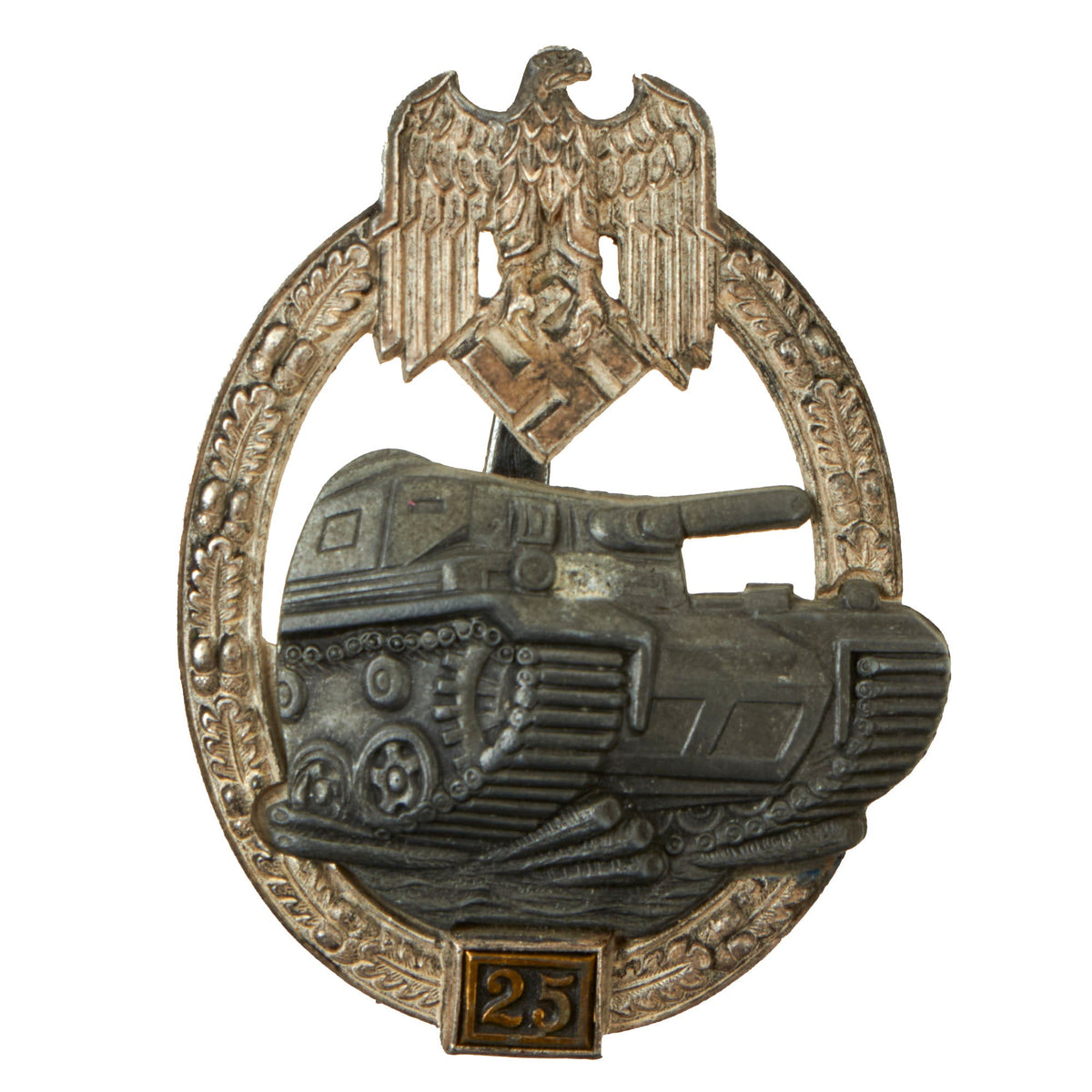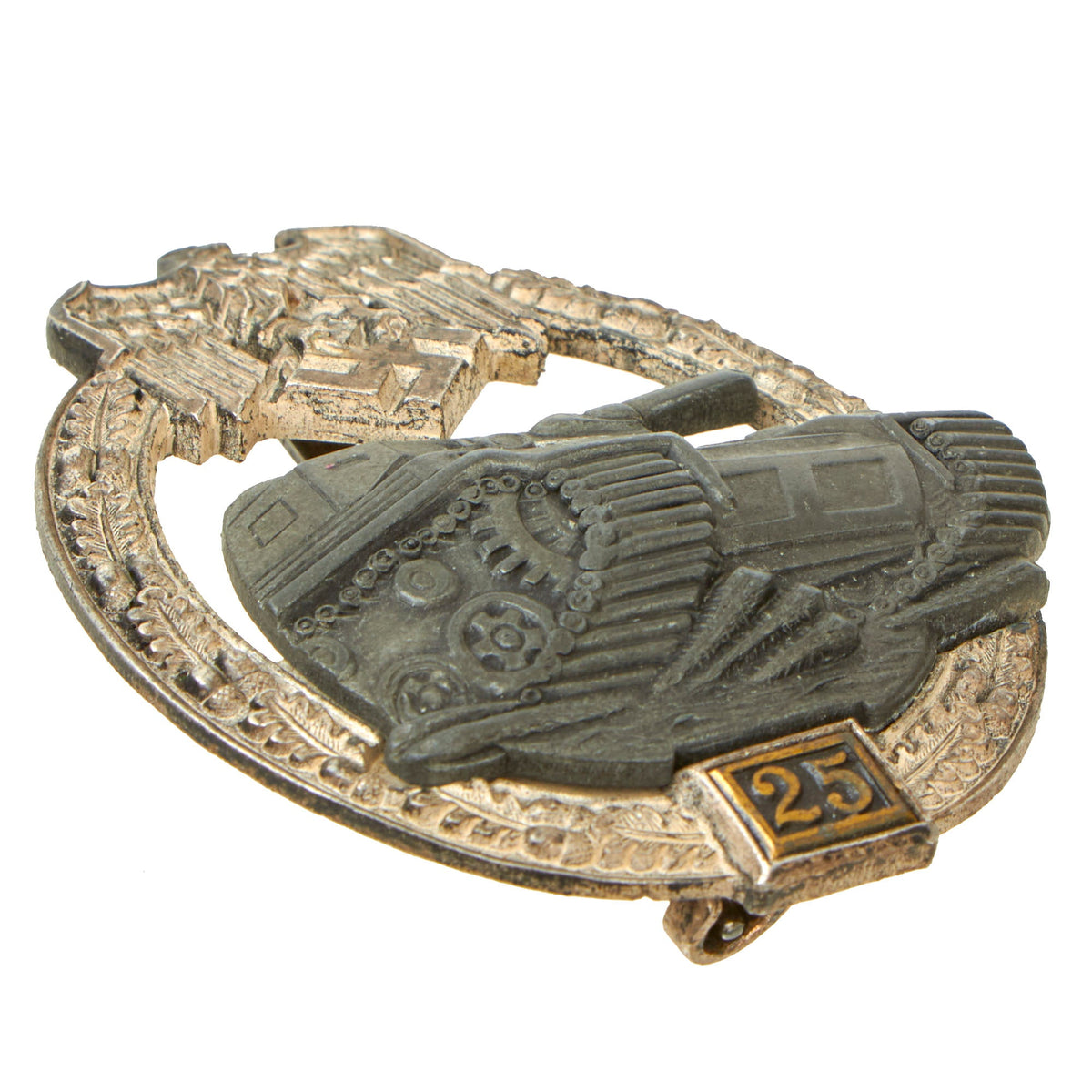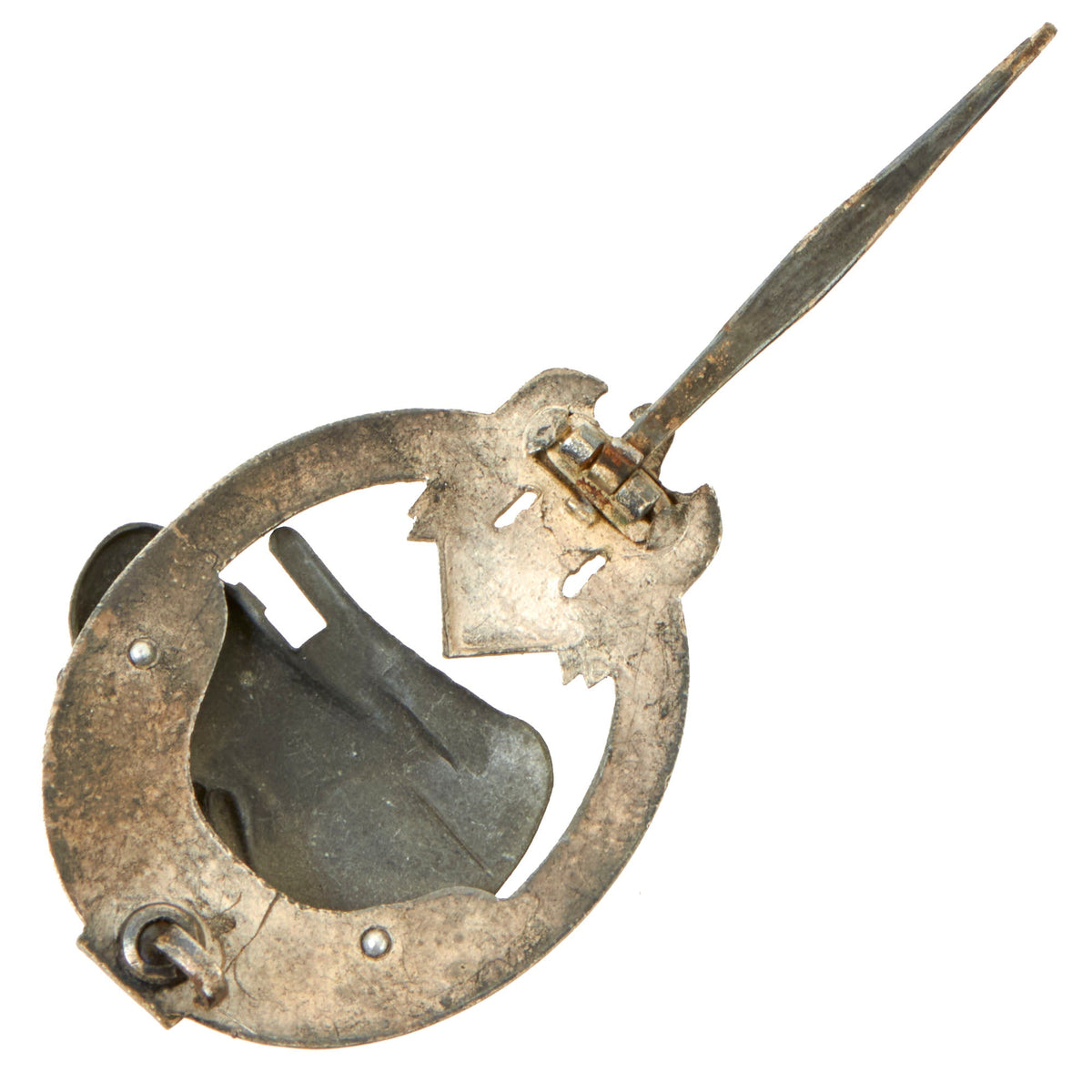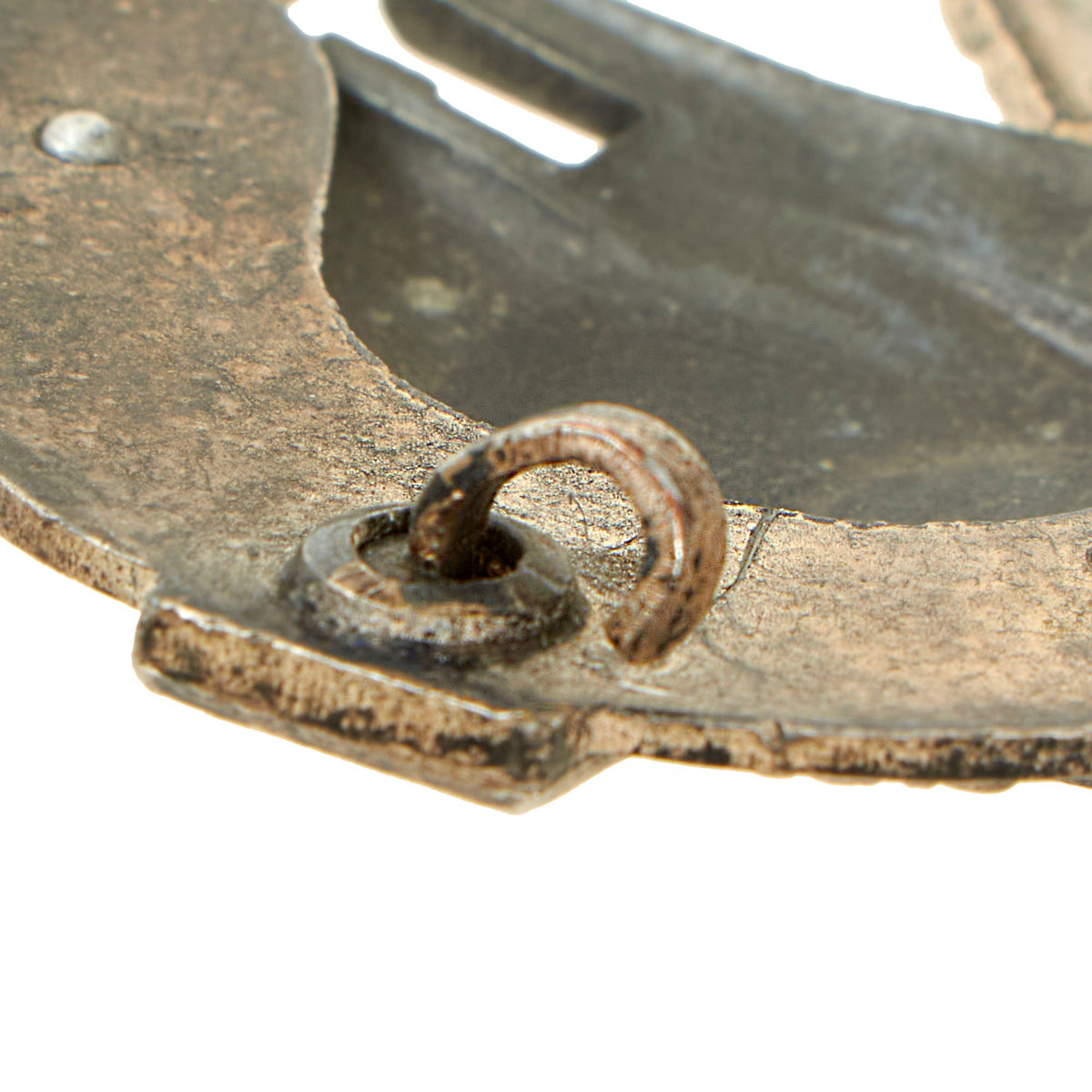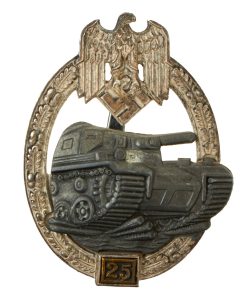Original German WWII 25 Engagement Panzer Assault Tank Badge by Josef Feix & Söhne – Unmarked Original Items
$ 2.895,00 $ 723,75
Original Item: Only One Available. This is a 25 Engagement Panzer Assault Badge in overall excellent condition. The badge is made of two separate pieces out of feinzinc. This badge is an unmarked textbook example by Josef Feix & Söhne of Gablonz. This city was part of the so-called “Sudetenland” during WWII, and today it is known as Jablonec nad Nisou in the Czech Rebublic. We have had one example of these before, and compared this to that example and other known examples, and the style of pin, hinge, and rivets are identical.
This is a lovely example, showing only light wear, with all the details still crisp and clear. The silvered outer wreath is in excellent condition and retains approximately 95% of its original silver finish, though it has tarnished a bit over the decades, especially on the reverse. The burnished tank is also in excellent condition, and retains roughly 95% of its original finish as well. Both pieces are held tightly together by two original aluminum rivets, but neither penetrates the front of the badge, indicating that this is a higher quality produced badge. Neither rivet shows any signs of tightening. The 25 at the bottom is still mostly bright.
The barrel hinge and catch are securely, and originally, pressed and soldered in place. The pin still retains its original silver wash finish indicting this badge did not receive much, if any, wear, and it is also tarnished like the back. This is a beautiful 25 Engagement Panzer Assault Badge in Silver by Josef Feix & Söhne that would make a welcome addition to any badge collection.
The Numbered Panzer Assault Badge was instituted on June 22, 1943. The instituting of the new grades of the Panzer Assault Badge was in a direct response to the increasing number of soldiers which had continued to tally “combat days” after they had met the initial requirements of the standard version. The different grades created by the German High Command were “25”, “50”, “75”, & “100”. The requirements for the Numbered Panzer Assault Badge was very similar to the standard version except the number of combat days required corresponded to the number of the award. For example, the Panzer Assault Badge with a “25” box would have required the soldier to have 25 combat assaults on 25 different days. Many soldiers in the German Army did not live to see the required “combat days” for the higher grades, most specifically the “75” & “100” grades.
The numbered grades used the same design pattern as the standard version. However, these grades of the Panzer Assault Badge have more enhanced features such as enlarged tank, wreath and eagle, plus the addition of a number box at the bottom of the wreath to denote grade.
The Panzer Assault Badge (German: Panzerkampfabzeichen) was a World War II German military decoration awarded troops in armored divisions. The badge was introduced on 20 December 1939, in order to recognize the achievements of Panzer personnel who took part in armored assaults. It was designed by the Berlin firm of Wilhelm Ernst Peekhaus, and was instituted by order of Generaloberst Walther von Brauchitsch. On 6 June 1940, a separate class of the badge, in Bronze, was added in order to recognize the crews of armored vehicles other than tanks. The award document that came with it was the common type that had the particulars of the recipient (rank, name) and the authorizing signature of an officer. The Panzer Badge was worn on the left tunic pocket. The bronze version of the Panzer Badge was authorized for armored personnel and Panzer grenadier units equipped with armoured vehicles. It was also to be presented to members of armored reconnaissance groups and rifle battalions of Panzer divisions. The authorization of these badges was usually done at a regimental or divisional level.
The term panzer division (German: Panzerdivision) as commonly used in English language refers almost exclusively to the armored (tank) division in the army branch of the Wehrmacht and of NSDAP Germany during World War II. The panzer divisions were the key element of German success in the Blitzkrieg operations of the early years of the war. Later the Waffen-SS formed panzer divisions, and even the Luftwaffe fielded a panzer division, the Herman Goring Division. The term Panzerdivision is still used in today’s Heer of the Bundeswehr (for example 1. Panzerdivision). In German speaking countries the term is not immediately associated with the Wehrmacht as it is in English speaking nations, as the word simply means ‘armored division’ and has no additional connotation.
A panzer division was a combined arms formation, having both tanks (German Panzerkampfwagen, “armored fighting vehicle”, usually shortened to “Panzer”) and infantry as organic components, along with artillery, anti-aircraft, signals, etc. However, the proportions of the components of a panzer division changed over time.
Fast Shipping with Professional Packaging
Thanks to our longstanding association with UPS FedEx DHL, and other major international carriers, we are able to provide a range of shipping options. Our warehouse staff is expertly trained and will wrap your products according to our exact and precise specifications. Prior to shipping, your goods will be thoroughly examined and securely secured. We ship to thousands clients each day across multiple countries. This shows how we're dedicated to be the largest retailer on the internet. Warehouses and distribution centres can be located throughout Europe as well as the USA.
Note: Orders with more than one item will be assigned a processing date depending on the item.
Before shipping before shipping, we'll conduct a thorough inspection of the items you have ordered. Today, the majority of orders will be delivered within 48 hours. The delivery time will be between 3-7 days.
Returns
The stock is dynamic and we cannot completely manage it because multiple stakeholders are involved, including our factory and warehouse. So the actual stock may alter at any time. It's possible that you may not receive your order once the order has been made.
Our policy is valid for a period of 30 days. If you don't receive the product within 30 days, we are not able to issue a refund or an exchange.
You can only return an item if it is unused and in the same state as the day you received it. You must have the item in its original packaging.
Related products
Uncategorized
Uncategorized
Uncategorized
Uncategorized
Uncategorized
Uncategorized
Angolan Rebel 1970s era 60mm Inert Display Mortar from Angolan Civil War Original Items
Uncategorized
Uncategorized
Uncategorized
Uncategorized
Uncategorized
Armoured Fighting Vehicles of the World: AFVs of World War One (Hardcover Book) New Made Items
Uncategorized
Armored Burgonet Helmet & Polearm from Scottish Castle Leith Hall Circa 1700 Original Items
Uncategorized
Band of Brothers ORIGINAL GERMAN WWII Le. F.H. 18 10.5cm ARTILLERY PIECE Original Items
Uncategorized
Uncategorized
Uncategorized
Uncategorized
Uncategorized
Uncategorized
Australian WWII Owen MK1 Machine Carbine SMG Custom Fabricated Replica with Sling Original Items
Uncategorized
